The Generation of Attenuated Mutants of East Asian Passiflora Virus via Deletion and Mutation in the N-Terminal Region of the HC-Pro Gene for Control through Cross-Protection
Abstract
1. Introduction
2. Materials and Methods
2.1. Virus Isolates and Culture
2.2. Tagging of EAPV-TW with GFP
2.3. Infectivity Assay
2.4. Generation of Attenuated EAPV Mutants by Modification of HC-Pro Gene
2.5. Time Course of Virus Accumulation by Enzyme-Linked Immunosorbent Assay (ELISA)
2.6. Genetic Stability of Mild Strain EAPV-d6I8
2.7. Cross-Protection Assay of the Attenuated Mutant EAPV-d6I8 against the Taiwan Severe Strain EAPV-TW-GFP
2.8. Cross-Protection Evaluation of the Attenuated Mutant EAPV-d6I8 against the Vietnam Severe Strain EAPV-GL1
3. Result
3.1. Infectivity of EAPV-TW-GFP
3.2. Symptoms Induced by Mutants EAPV-d6 and EAPV-d6I8 in N. Benthamiana and Yellow Passionfruit Plants
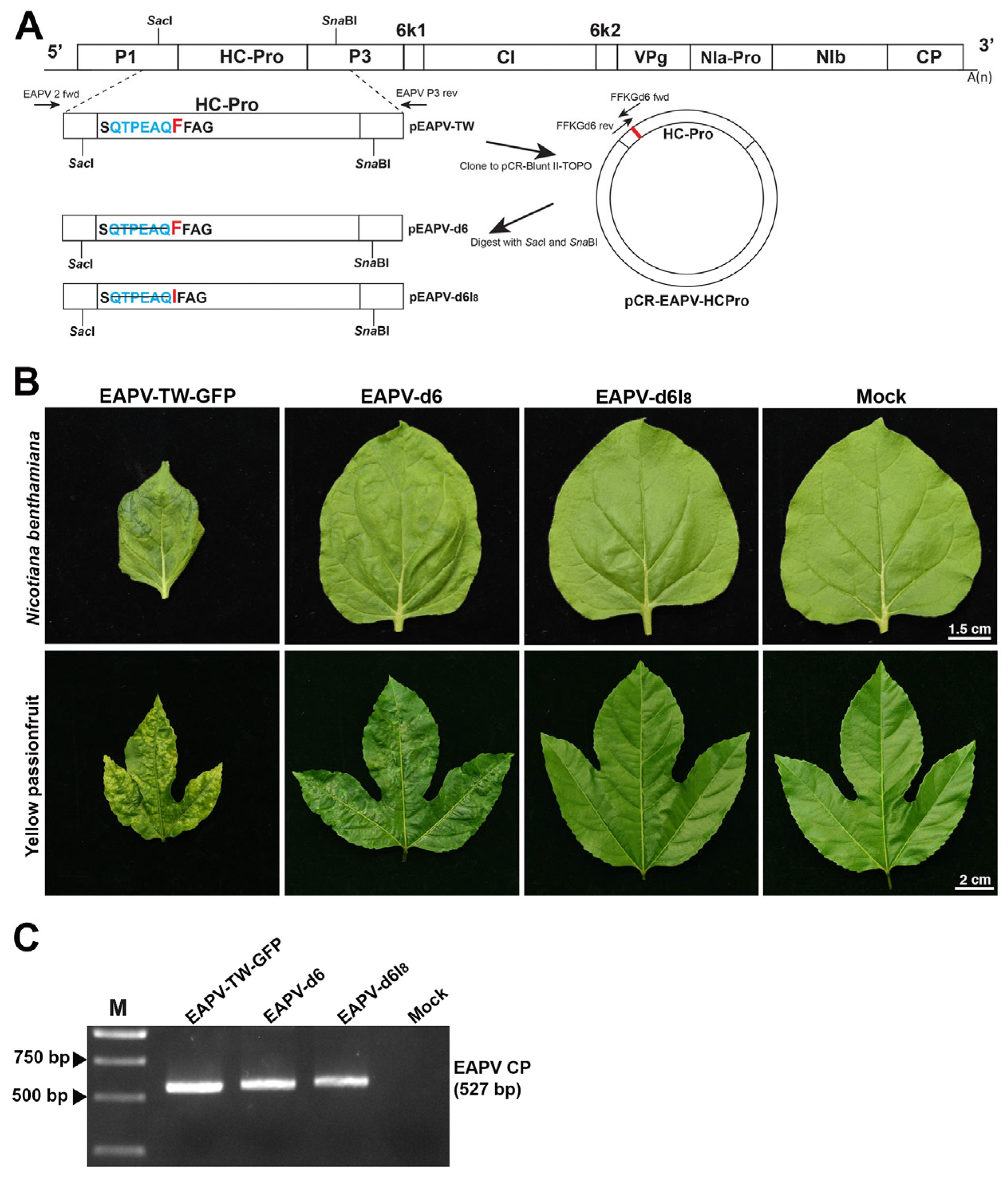
3.3. Accumulation Dynamics of EAPV Mutants
3.4. The Stability of Attenuated Strain in Passionfruit Plants
3.5. Cross-Protection Effectiveness of EAPV Mutants against Taiwan EAPV Severe Strain
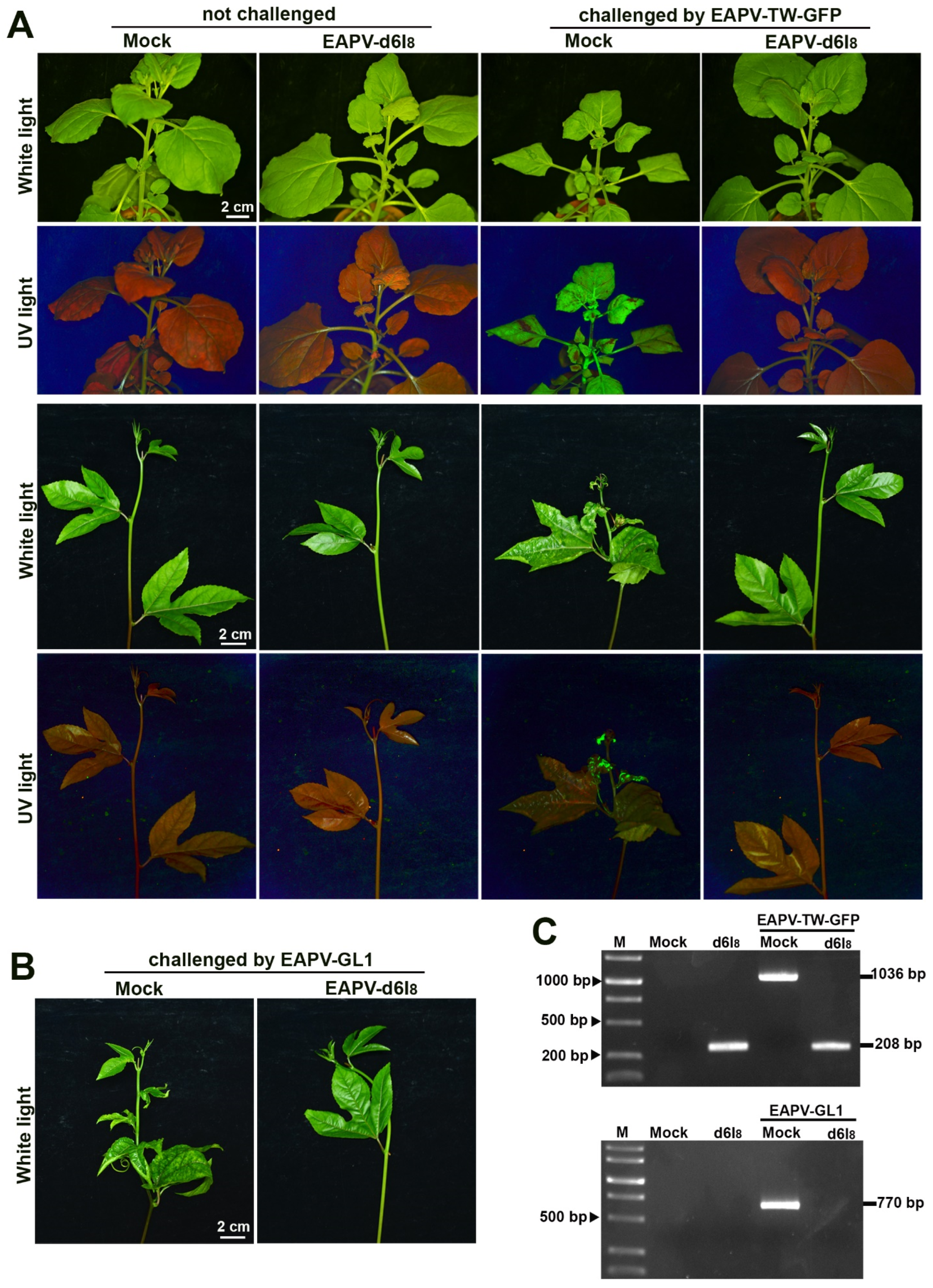
3.6. Cross-Protection Effectiveness of EAPV Mutants against Vietnam EAPV Severe Strain
4. Discussion
Author Contributions
Funding
Institutional Review Board Statement
Informed Consent Statement
Data Availability Statement
Conflicts of Interest
References
- Rodriguez-Amaya, D.B. Passion Fruit. In Tropical and Subtropical Fruits; Siddiq, M., Ed.; John Wiley and Sons: Hoboken, NJ, USA, 2012; pp. 321–332. [Google Scholar]
- Chong, Y.H.; Cheng, Y.H.; Cheng, H.W.; Huang, Y.C.; Yeh, S.D. The virus causing passionfruit woodiness disease in Taiwan is reclassified as East Asian Passiflora virus. J. Gen. Plant Pathol. 2018, 84, 208–220. [Google Scholar] [CrossRef]
- Do, D.H.; Chong, Y.H.; Ha, V.C.; Cheng, H.W.; Chen, Y.K.; Bui, T.N.L.; Nguyen, T.B.N.; Yeh, S.D. Characterization and detection of Passiflora mottle virus and two other potyviruses causing passionfruit woodiness disease in Vietnam. Phytopathology 2021, 111, 1675–1685. [Google Scholar] [CrossRef] [PubMed]
- Cerqueira-Silva, C.B.M.; Conceicao, L.D.H.C.S.; Souza, A.P.; Correa, R.X. A history of passion fruit woodiness disease with emphasis on the current situation in Brazil and prospects for Brazilian passion fruit cultivation. Eur. J. Plant Pathol. 2014, 139, 261–270. [Google Scholar] [CrossRef]
- McKnight, T. The woodiness virus of the passion vine (Passiflora edulis Sims). Qld. J. Agric. Sci. 1953, 10, 4–35. [Google Scholar]
- Taylor, R.H.; Greber, R.S. Passionfruit woodiness virus. In CMI/AAB Descriptions of Plant Viruses; Springer: Berlin/Heidelberg, Germany, 1973; p. 122. [Google Scholar]
- Brand, R.J.; Burger, J.T.; Rybicki, E.P. Cloning, sequencing, and expression in Escherichia coli of the coat protein gene of a new potyvirus infecting South African Passiflora. Arch. Virol. 1993, 128, 29–41. [Google Scholar] [CrossRef] [PubMed]
- McKern, N.M.; Strike, P.M.; Barnett, O.W.; Dijkstra, J.; Shukla, D.D.; Ward, C.W. Cowpea aphid borne mosaic virus-Morocco and South African Passiflora virus are strains of the same potyvirus. Arch. Virol. 1994, 136, 207–217. [Google Scholar] [CrossRef] [PubMed]
- Nascimento, A.V.S.; Santana, E.N.; Braz, A.S.K.; Alfenas, P.F.; Pio-Ribeiro, G.; Andrade, G.P.; De Carvalho, M.G.; Zerbini, F.M. Cowpea aphid-borne mosaic virus (CABMV) is widespread in passionfruit in Brazil and causes passionfruit woodiness disease. Arch. Virol. 2006, 151, 1797–1809. [Google Scholar] [CrossRef] [PubMed]
- Ochwo-Ssemakula, M.; Sengooba, T.; Hakiza, J.; Adipala, E.; Edema, R.; Redinbaugh, M.; Aritua, V.; Winter, S. Characterization and distribution of a Potyvirus associated with passion fruit woodiness disease in Uganda. Plant Dis. 2012, 96, 659–665. [Google Scholar] [CrossRef] [PubMed]
- Iwai, H.; Terahara, R.; Yamashita, Y.; Ueda, S.; Nakamura, M. Complete nucleotide sequence of the genomic RNA of an Amami-O-shima strain of East Asian Passiflora potyvirus. Arch. Virol. 2006, 151, 1457–1460. [Google Scholar] [CrossRef]
- Xie, L.X.; Zhang, L.J.; Zhang, X.Y.; Zheng, S.; Li, T. First report of East Asian Passiflora virus infecting Passiflora edulis in Fujian, China. Acta Hortic. Sin. 2018, 45, 1587–1594. [Google Scholar]
- Chiemsombat, P.; Prammanee, S.; Pipattanawong, N. Occurrence of Telosma mosaic virus causing passion fruit severe mosaic disease in Thailand and immunostrip test for rapid virus detection. Crop Prot. 2014, 63, 41–47. [Google Scholar] [CrossRef]
- Yang, K.; Yan, H.X.; Song, L.; Jin, P.F.; Miao, W.G.; Cui, H.G. Analysis of the complete genome sequence of a potyvirus from passion fruit suggests its taxonomic classification as a member of a new species. Arch. Virol. 2018, 163, 2583–2586. [Google Scholar] [CrossRef] [PubMed]
- Riska; Sato, Y.; Inudo, K.; Nakamura, M.; Fukumoto, T.; Takushi, T.; Fuji, S.I.; Iwai, H. East Asian Passiflora distortion virus: A novel potyvirus species causing deformation of passionfruits in Japan. J. Gen. Plant Pathol. 2019, 85, 221–231. [Google Scholar] [CrossRef]
- Iwai, H.; Ohmori, T.; Kurokawa, Y.; Muta, T.; Arai, K. New record of passionfruit woodiness virus in Japan. Jpn. J. Phytopathol. 1996, 62, 459–465. [Google Scholar] [CrossRef]
- Iwai, H.; Yamashita, Y.; Nishi, N.; Nakamura, M. The potyvirus associated with the dappled fruit of Passiflora edulis in Kagoshima prefecture, Japan is the third strain of the proposed new species East Asian Passiflora virus (EAPV) phylogenetically distinguished from strains of Passion fruit woodiness virus. Arch. Virol. 2006, 151, 811–818. [Google Scholar] [PubMed]
- Chang, C.A. Characterization and comparison of passionfruit mottle virus, a newly recognized potyvirus, with passionfruit woodiness virus. Phytopathology 1992, 82, 1358–1363. [Google Scholar] [CrossRef]
- Jan, F.J.; Yeh, S.D. Purification, in situ localization, and comparative serological properties of passionfruit woodiness virus-encoded amorphous inclusion protein and two other virus proteins. Phytopathology 1995, 85, 64–71. [Google Scholar] [CrossRef]
- Norzihan, A.; Ismanizan, I.; Vilasini, P.; Ruslan, A.; Shaiful, A.S. Nucleotide sequence of the coat protein gene of the Malaysian Passiflora Virus and its 3′ non-coding region. Am. J. Appl. Sci. 2009, 6, 1633–1636. [Google Scholar]
- Pechinger, K.; Chooi, K.M.; MacDiarmid, R.M.; Harper, S.J.; Ziebell, H. A new era for mild strain cross-protection. Viruses 2019, 11, 670. [Google Scholar] [CrossRef]
- Ziebell, H.; Carr, J.P. Cross-protection: A century of mystery. Adv. Virus Res. 2010, 76, 211–264. [Google Scholar]
- Cassells, A.C.; Herrick, C.C. Cross Protection between mild and severe strains of tobacco mosaic virus in doubly inoculated tomato plants. Virology 1977, 78, 253–260. [Google Scholar] [CrossRef] [PubMed]
- Rast, A.T.B. M II-16, an artificial symptomless mutant of tobacco mosaic virus for seedling inoculation of tomato crops. Neth. J. Plant Pathol. 1972, 78, 110–112. [Google Scholar] [CrossRef]
- Yeh, S.D.; Gonsalves, D. Evaluation of induced mutants of papaya ringspot virus for control by cross protection. Phytopathology 1984, 74, 1086–1091. [Google Scholar] [CrossRef]
- Müller, G.W.; Costa, A.S. Tristeza control in Brazil by preimmunization with mild strains. Proc. Int. Soc. Citric. 1977, 3, 868–872. [Google Scholar]
- Lecoq, H.; Lemaire, J.-M.; Wipf-Scheibel, C. Control of zucchini yellow mosaic virus in squash by cross protection. Plant Dis. 1991, 75, 208–211. [Google Scholar] [CrossRef]
- Lin, S.S.; Wu, H.W.; Jan, F.J.; Hou, R.F.; Yeh, S.D. Modifications of the helper component-protease of Zucchini yellow mosaic virus for generation of attenuated mutants for cross protection against severe infection. Phytopathology 2007, 97, 287–296. [Google Scholar] [CrossRef] [PubMed]
- Aguero, J.; Gomez-Aix, C.; Sempere, R.N.; Garcia-Villalba, J.; Garcia-Nunez, J.; Hernando, Y.; Aranda, M.A. Stable and broad spectrum cross-protection against pepino mosaic virus attained by mixed infection. Front. Plant Sci. 2018, 9, 1810. [Google Scholar] [CrossRef] [PubMed]
- Simmonds, J.H. Mild strain protection as a means of reducing losses from the Queensland woodiness virus in the passion vine. Qld. J. Agric. Sci. 1959, 16, 371–380. [Google Scholar]
- Novaes, Q.S.D.; Rezende, J.A.M. Selected mild strains of Passion fruit woodiness virus (PWV) fail to protect pre-immunized vines in Brazil. Sci. Agric. 2003, 60, 699–708. [Google Scholar] [CrossRef]
- Maia, I.G.; Haenni, A.-L.; Bernardi, F. Potyviral HC-Pro: A multifunctional protein. J. Gen. Virol. 1996, 77, 1335–1341. [Google Scholar] [CrossRef]
- Valli, A.A.; Gallo, A.; Rodamilans, B.; Lopez-Moya, J.J.; Garcia, J.A. The HCPro from the Potyviridae family: An enviable multitasking Helper Component that every virus would like to have. Mol. Plant Pathol. 2018, 19, 744–763. [Google Scholar] [CrossRef] [PubMed]
- Kung, Y.J.; Lin, P.C.; Yeh, S.D.; Hong, S.F.; Chua, N.H.; Liu, L.Y.; Lin, C.P.; Huang, Y.H.; Wu, H.W.; Chen, C.C.; et al. Genetic analyses of the FRNK motif function of Turnip mosaic virus uncover multiple and potentially interactive pathways of cross-protection. Mol. Plant-Microbe Interact. 2014, 27, 944–955. [Google Scholar] [CrossRef] [PubMed]
- Raja, J.A.J.; Huang, C.H.; Chen, C.C.; Hu, W.C.; Cheng, H.W.; Goh, R.P.; Chao, C.H.; Tan, Y.R.; Yeh, S.D. Modification of the N-terminal FWKG-αH1 element of potyviral HC-Pro affects its multiple functions and generates effective attenuated mutants for cross-protection. Mol. Plant Pathol. 2022, 23, 947–965. [Google Scholar] [CrossRef]
- Gal-On, A.; Raccah, B. A point mutation in the FRNK motif of the potyvirus helper component-protease gene alters symptom expression in cucurbits and elicits protection against the severe homologous virus. Phytopathology 2000, 90, 467–473. [Google Scholar] [CrossRef] [PubMed]
- Cheng, H.-W.; Lin, T.-T.; Huang, C.-H.; Raja, J.A.; Yeh, S.-D. Modification of papaya ringspot virus HC-Pro to generate effective attenuated mutants for overcoming the problem of strain-specific cross protection. Plant Dis. 2023, 107, 1757–1768. [Google Scholar] [CrossRef] [PubMed]
- Tran, T.T.Y.; Cheng, H.W.; Nguyen, V.H.; Yeh, S.D. Modification of the helper-component protease of papaya ringspot virus Vietnam isolate to generate attenuated mutants for disease management by cross protection. Phytopathology 2023, 113, 334–344. [Google Scholar] [CrossRef] [PubMed]
- Chong, Y.-H.; Do, D.-H.; Cheng, H.-W.; Raja, J.A.; Ngo, X.-T.; Hwang, S.-G.; Yeh, S.-D. Generation of attenuated mutants of East Asian Passiflora virus for disease management by cross protection. Mol. Plant-Microbe Interact. 2023, 36, 345–358. [Google Scholar] [CrossRef] [PubMed]
- Hsu, C.H.; Lin, S.S.; Liu, F.L.; Su, W.C.; Yeh, S.D. Oral administration of a mite allergen expressed by zucchini yellow mosaic virus in cucurbit species downregulates allergen-induced airway inflammation and IgE synthesis. J. Allergy Clin. Immunol. 2004, 113, 1079–1085. [Google Scholar] [CrossRef]
- Yeh, S.D.; Gonsalves, D. Purification and immunological analyses of cylindrical-inclusion protein-induced by papaya ringspot virus and watermelon mosaic virus-1. Phytopathology 1984, 74, 1273–1278. [Google Scholar] [CrossRef]
- Chen, C.C.; Chen, T.C.; Raja, J.A.; Chang, C.A.; Chen, L.W.; Lin, S.S.; Yeh, S.D. Effectiveness and stability of heterologous proteins expressed in plants by Turnip mosaic virus vector at five different insertion sites. Virus Res. 2007, 130, 210–227. [Google Scholar] [CrossRef]
- Do, D.H.; Nguyen, T.B.N.; Ha, V.C.; Raja, J.A.; Yeh, S.-D. Generation of attenuated Passiflora mottle virus through modification of the helper component-protease for cross protection. Phytopathology 2023, 113, 1605–1614. [Google Scholar] [CrossRef] [PubMed]
- Ziebell, H.; MacDiarmid, R. Prospects for engineering and improvement of cross-protective virus strains. Curr. Opin. Virol. 2017, 26, 8–14. [Google Scholar] [CrossRef]
- Hasiów-Jaroszewska, B.; Borodynko, N.; Jackowiak, P.; Figlerowicz, M.; Pospieszny, H. Single mutation converts mild pathotype of the Pepino mosaic virus into necrotic one. Virus Res. 2011, 159, 57–61. [Google Scholar] [CrossRef] [PubMed]
- Fulton, R.W. Practices and precautions in the use of cross protection for plant virus disease control. Annu. Rev. Phytopathol. 1986, 24, 67–81. [Google Scholar] [CrossRef]
- Pares, R.D.; Martin, A.B.; Fitzell, R.D. Virus-induced tip necrosis of passionfruit Passiflora edulis Sims. Australas. Plant Pathol. 1985, 14, 76–78. [Google Scholar] [CrossRef]
- Chang, C.A.; Wang, H.L.; Chen, Y.L.; Chou, T.Y. The investigation and identification of virus diseases of passionfruit in Taiwan. Plant Prot. Bull. 1981, 23, 267. [Google Scholar]
- Tran, T.-N.-B.; Cheng, H.-W.; Xie, X.-Y.; Raja, J.A.; Yeh, S.-D. Concurrent control of two aphid-borne potyviruses in cucurbits by two-in-one vaccine. Phytopathology 2023, 113, 1583–1594. [Google Scholar] [CrossRef]
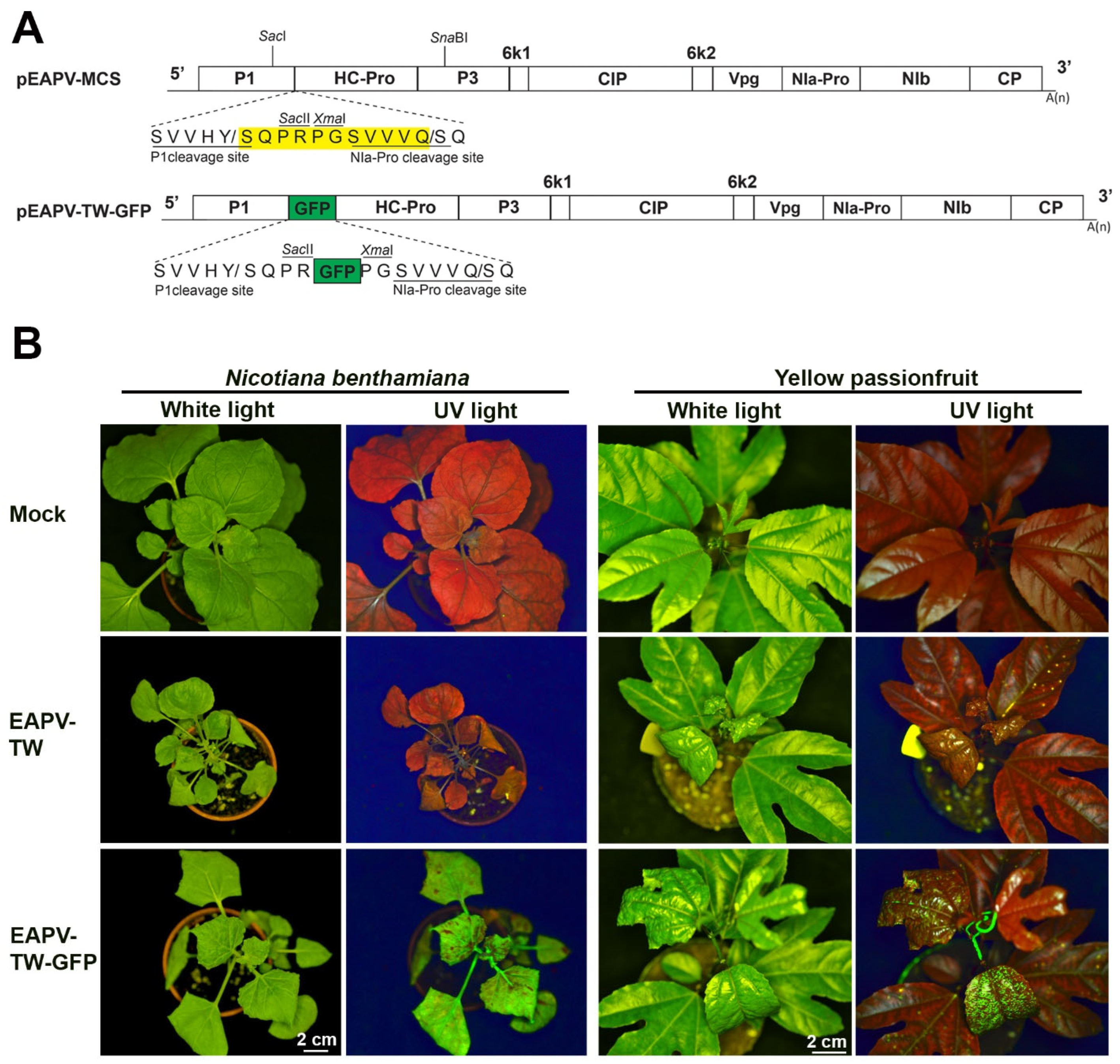
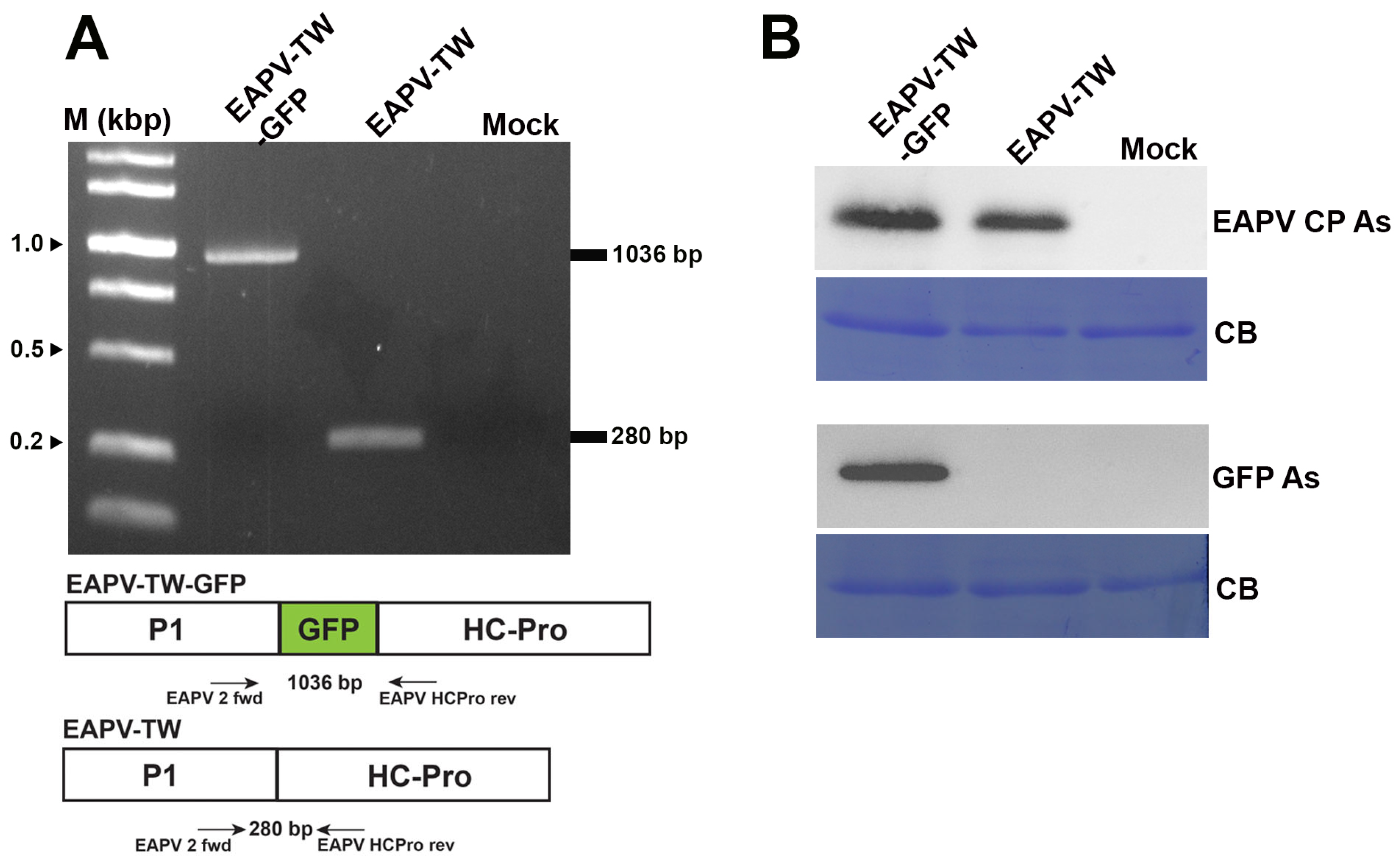
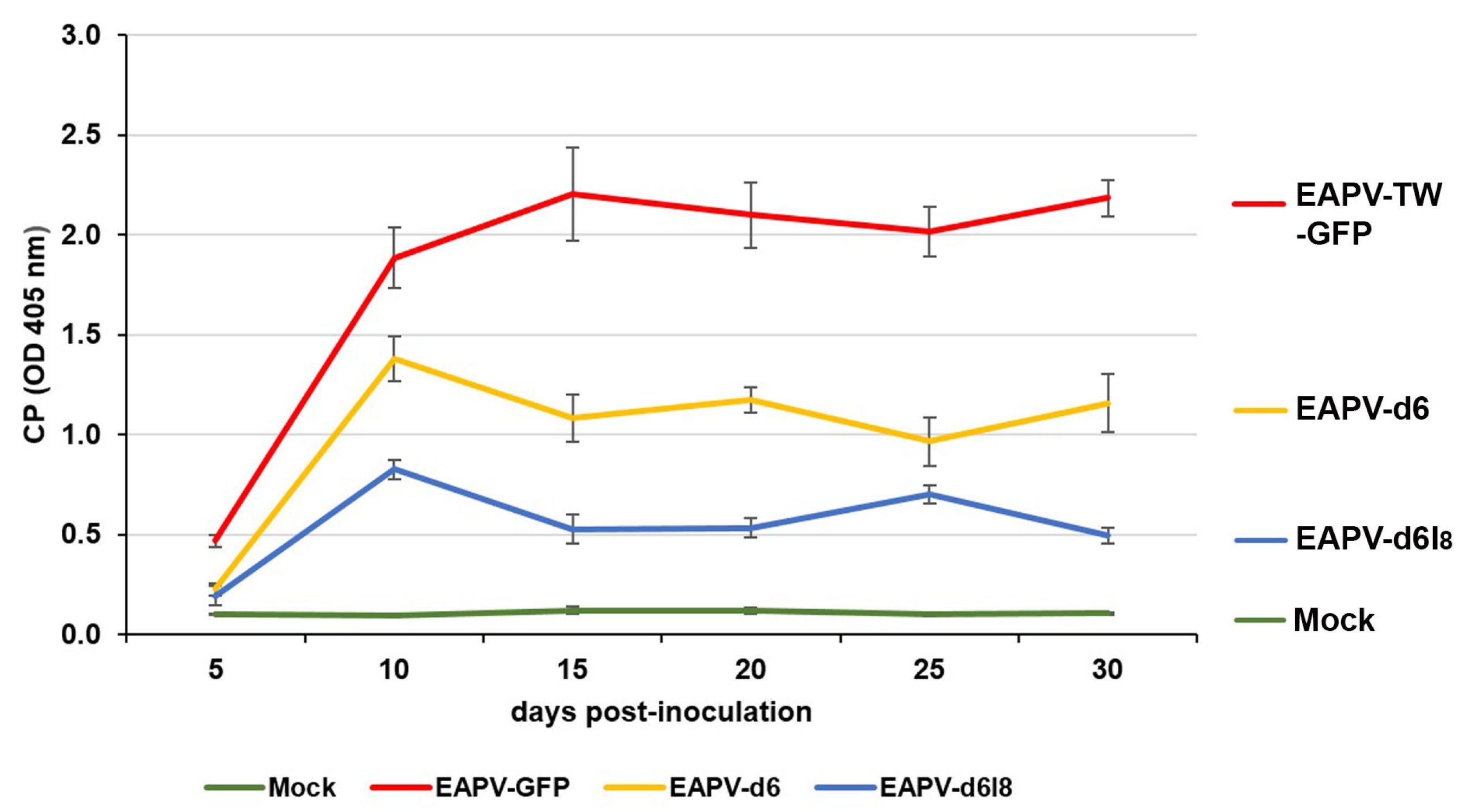
| Name | Sequence 5′-3′ | Underline Note |
|---|---|---|
| Cloning primer | ||
| EAPV 2 fwd | GAGGACGTATGGGAACAAAGTTAG | |
| P1HCPro fwd | GCCCCCGGGGACTCAGTTGTTGTCCAGTCACAAACACCTGAGGCTCA | XmaI |
| P1HCPro rev | AACTGAGTCCCCGGGGGCCCGCGGTGTTTGTGAGTAGTGCACAACAC | XmaI, SacII |
| EAPV P3 rev | CAAGCTTAGCGCGTGCCACTCCTG | |
| GFP SacII fwd | ACACCGCGGATGGTGAGTAAAGGAGAAGAACTT | SacII |
| GFP XmaI rev | AGTCCCGGGTTTGTATAGTTCATCCATGCC | XmaI |
| EAPV P1 fwd | GATGAACAAATCAAGCGTGGTGA | |
| EAPV HCPro rev | CCCCACATTGAGCATTCGCAAAA | |
| Site direct mutagenesis primers | ||
| EAPVd6 fwd | GTGCACTACTCATTTTTCGCCGGCTGGAAGAAG | |
| EAPVd6 rev | GGCGAAAAATGAGTAGTGCACAACACTCTCTTT | |
| EAPVd6F8I fwd | ATTTTCGCAGGATGGAAGAAGGTTTTTGATAGG | |
| EAPVd6F8I rev | CTTCTTCCATCCTGCGAAAATTGAGTAGTGTAC | |
| Detection | ||
| EAPV CP fwd | CCCATGGTATTCAGCAGTCCAAAGAG | |
| EAPV CP rev | GGGAATTCATACCCAAAAGGGTGT | |
| GL1 9042 fwd | CACAACCCCGATAAATCCAAATC | |
Disclaimer/Publisher’s Note: The statements, opinions and data contained in all publications are solely those of the individual author(s) and contributor(s) and not of MDPI and/or the editor(s). MDPI and/or the editor(s) disclaim responsibility for any injury to people or property resulting from any ideas, methods, instructions or products referred to in the content. |
© 2024 by the authors. Licensee MDPI, Basel, Switzerland. This article is an open access article distributed under the terms and conditions of the Creative Commons Attribution (CC BY) license (https://creativecommons.org/licenses/by/4.0/).
Share and Cite
Do, D.-H.; Ngo, X.-T.; Yeh, S.-D. The Generation of Attenuated Mutants of East Asian Passiflora Virus via Deletion and Mutation in the N-Terminal Region of the HC-Pro Gene for Control through Cross-Protection. Viruses 2024, 16, 1231. https://doi.org/10.3390/v16081231
Do D-H, Ngo X-T, Yeh S-D. The Generation of Attenuated Mutants of East Asian Passiflora Virus via Deletion and Mutation in the N-Terminal Region of the HC-Pro Gene for Control through Cross-Protection. Viruses. 2024; 16(8):1231. https://doi.org/10.3390/v16081231
Chicago/Turabian StyleDo, Duy-Hung, Xuan-Tung Ngo, and Shyi-Dong Yeh. 2024. "The Generation of Attenuated Mutants of East Asian Passiflora Virus via Deletion and Mutation in the N-Terminal Region of the HC-Pro Gene for Control through Cross-Protection" Viruses 16, no. 8: 1231. https://doi.org/10.3390/v16081231
APA StyleDo, D.-H., Ngo, X.-T., & Yeh, S.-D. (2024). The Generation of Attenuated Mutants of East Asian Passiflora Virus via Deletion and Mutation in the N-Terminal Region of the HC-Pro Gene for Control through Cross-Protection. Viruses, 16(8), 1231. https://doi.org/10.3390/v16081231






